An Exquisite Spectrum: Unraveling the Mystery of Pink Birds in Florida. Exploring the World of Pink Birds: A Journey Through Florida’s Avian Wonders. Florida’s Feathered Spectrum: An Insight Into Its Pink Bird Diversity
Florida, the Sunshine State, is a tropical paradise not only for its residents and millions of tourists but also for a diverse array of bird species. Florida is a bird-watcher’s heaven, encompassing various habitats – from marshes and wetlands to forests and coastal regions. However, amongst the vast array of colors and species, one group captures the imagination like no other – the pink birds of Florida.
| Bird Species | Key Identification Features |
|---|---|
| American Flamingo | Large bird with a distinctive pink color, long neck, and legs. The beak has a unique shape – bent in the middle. |
| Roseate Spoonbill | Medium-sized wading bird with a long, spoon-shaped bill. The body is a mix of white, pink, and scarlet. |
| Scarlet Ibis | This bird is entirely scarlet, except for black wingtips. It has a long, curved bill. |
| Purple Finch | Small bird with a unique pink-red or raspberry color on the head and chest, brown streaks on the back, and wings. |
| House Finch | A small bird with a brownish body. Males have a red or pinkish color on the head, chest, and back. |
| Roseate Tern | Medium-sized seabird with a pale pink chest and belly during the breeding season. It has a black cap and a deeply forked tail. |
| Rose-Breasted Grosbeak | Medium-sized songbird. Males have a black and white body with a distinctive rosy patch on their chest. |
The pink birds in Florida, ranging from the iconic flamingos to the less-known grosbeaks, create a vibrant and enticing spectacle for bird enthusiasts and casual observers alike. The rosy hues of these birds add a unique charm to Florida’s wildlife and pose intriguing questions about their adaptation and survival.
The famous pink flamingos, often seen as the symbol of tropical elegance, are a significant attraction in Florida. But, the avian treasure of Florida is not just limited to these majestic birds. A closer look reveals a spectrum of pink birds, each with unique attributes, habitats, and behaviors. In the following sections, we’ll delve into the fascinating world of these feathered beauties, providing a comprehensive guide to identifying and appreciating Florida’s pink birds.
Contents
The next time you’re in Florida, armed with the knowledge from this guide, you’ll be able to tell which pink bird is perched on a nearby tree or wading in the waters. After all, every bird has a story to tell, and each sighting is an opportunity to unravel a piece of the grand puzzle of Florida’s diverse avian life.
The Unique Spoonbills
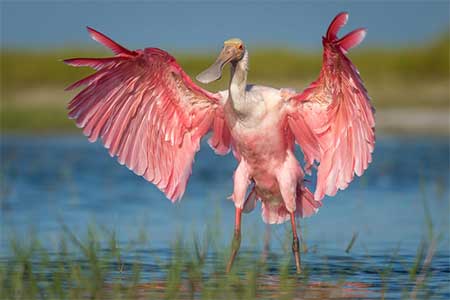 As we unravel the pink feathered wonders of Florida, it’s impossible to overlook the intriguing and distinctive Roseate Spoonbill. Aptly named for its spatulate bill, the Roseate Spoonbill is an exquisite spectacle of nature that sparks curiosity and wonderment in equal measure.
As we unravel the pink feathered wonders of Florida, it’s impossible to overlook the intriguing and distinctive Roseate Spoonbill. Aptly named for its spatulate bill, the Roseate Spoonbill is an exquisite spectacle of nature that sparks curiosity and wonderment in equal measure.
| Feature | Description |
|---|---|
| Size | Large wading bird with a length of 28-34 inches and a wingspan of 47-52 inches. |
| Color | Adults display a brilliant pink body, brighter on the nice wings, and a white neck and upper chest. Immature birds are paler. |
| Bill | Long, flat and spoon-shaped at the end, giving the bird its name. |
| Legs | Long and grayish, suitable for wading. |
| Eyes | Reddish, surrounded by a patch of featherless, greenish skin. |
The Roseate Spoonbill, a resident of the wetlands, is distributed across the southern parts of Florida, particularly in places like the Everglades National Park and Sanibel Island. It favors marshes, swamps, ponds, and lagoons, where it can wade in shallow waters. Coastal areas, tidal ponds, and mangroves also form part of its habitat.
Regarding feeding habits, the Roseate Spoonbill’s diet primarily consists of small fish, crustaceans, particularly shrimp, and aquatic insects. It feeds by sweeping its open bill from side to side in the shallow water. When it touches a prey item, the bill snaps shut.
The Roseate Spoonbill is often compared to the iconic Flamingo due to its similar pink hue. However, it’s important to note that their coloration stems from different sources. While flamingos get their color from eating brine shrimp and blue-green algae, spoonbills feed on crustaceans rich in pigments called carotenoids, which give them their characteristic pink color.
Conservation and the Roseate Spoonbill have had a long-standing relationship. In the late Nineteenth and at the beginning of the early 20th centuries, these birds were hunted extensively for their beautiful feathers, leading to a significant decline in their population. The Migratory Bird Treaty Act in the Revolutionary 1918 provided them with some protection, helping their numbers rebound in some areas.
The Roseate Spoonbill is listed as ‘Least Concern’ by the IUCN, but it continues to face several threats. Loss and degradation of wetlands, their primary habitat, due to urban development and agriculture pose significant challenges. Additionally, water pollution leading to a decline in prey availability is another threat to these birds.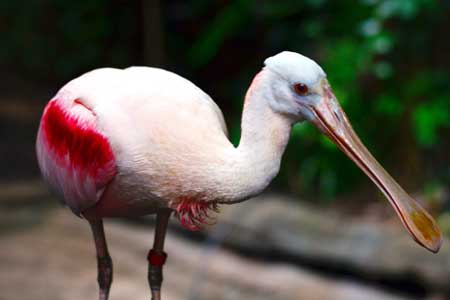
In Florida, conservation efforts are ongoing to protect the habitats of these unique birds. Organizations such as the Florida Audubon Society are involved in research, habitat restoration, and public education to aid in the conservation of the Roseate Spoonbill. By understanding their needs and threats, we can ensure that future generations also marvel at these pink wonders of the avian world.
The Vibrant Scarlet Ibis
 Diving deeper into the realm of Florida’s pink avifauna, we encounter an occasional visitor with striking plumage, the Scarlet Ibis. Despite being a non-native species, the Scarlet Ibis adds a unique splash of color to Florida’s bird life.
Diving deeper into the realm of Florida’s pink avifauna, we encounter an occasional visitor with striking plumage, the Scarlet Ibis. Despite being a non-native species, the Scarlet Ibis adds a unique splash of color to Florida’s bird life.
| Feature | Description |
|---|---|
| Size | Medium-sized bird, typically 22-24 inches long with a wingspan of around 21 inches. |
| Color | Bright red to scarlet body, with black tips on the wings. Immature birds are a mix of brown, grey, and white. |
| Bill | Long, thin, and curved downward. |
| Legs | Long and grey, adapted for wading. |
| Eyes | Dark brown or black. |
The Scarlet Ibis is happily native to South America and the Caribbean. It’s an occasional visitor in Florida, primarily seen in the southern parts of the state. The species favors wetland habitats like marshes, swamps, and mudflats.
When it comes to diet, the Scarlet Ibis is an opportunist feeder. It primarily feeds on crustaceans, mainly crabs and shrimps, but also includes insects, fish, and other small creatures in its menu.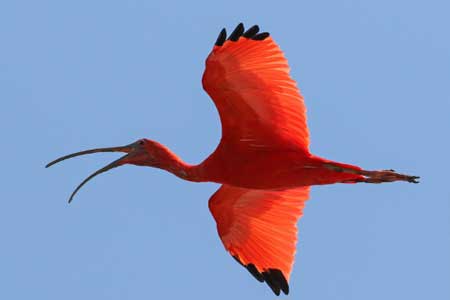
One must discuss the Scarlet Ibis by marveling at its unique coloration. The bird’s striking scarlet color comes from its diet. Like flamingos and spoonbills, Scarlet Ibises ingest carotenoid-rich food items, such as red crustaceans, contributing to their vibrant red color.
While the Scarlet Ibis is not a permanent resident of Florida, its occasional presence underscores the state’s rich biodiversity. These radiant birds embody the diverse and colorful bird life the state is home to.
As part of Florida’s ecosystems, the Scarlet Ibis plays a vital role. By feeding on crustaceans and other small creatures, they help to control these populations, maintaining a balance in their habitats. Their feeding habits also contribute to nutrient cycling in their ecosystems.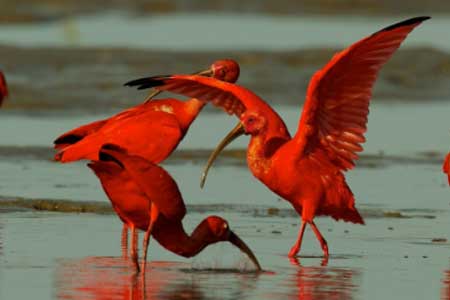
As we continue to explore Florida’s pink birds, the presence of the Scarlet Ibis reminds us of the state’s rich and diverse avifauna. Whether a permanent resident or an occasional visitor, each species plays its part in the vibrant tapestry of Florida’s bird life.
The Small but Colorful Finches
Although the larger pink birds of Florida often steal the spotlight, the state’s avifauna is also graced by some small yet vibrantly-colored finches. Among these are the Purple Finch and the House Finch.
The Purple Finch
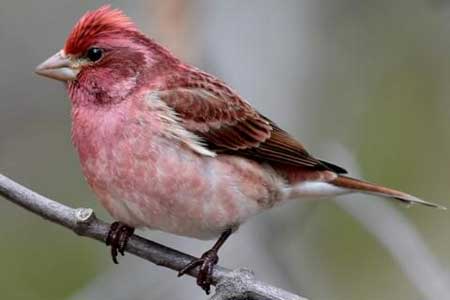
Despite its name, the Purple Finch is more of a crimson color than purple. The males are a raspberry red on the head and back, becoming more subdued on the belly, while females and juveniles are primarily brown and streaky.
| Feature | Description |
|---|---|
| Size | Small bird, about 5.5 to 6 inches long. |
| Color | Males have raspberry red coloration on the head, back, and chest. Females and juveniles are brown and streaky. |
| Bill | Short, conical, and suited for cracking seeds. |
| Legs | Short and pinkish. |
| Eyes | Dark brown. |
Purple Finches are primarily found in forested areas but can also be seen in backyards and parks. Their diet consists of small seeds, berries, and insects.
Compared to other finches, Purple Finches are more extensive and bulkier, with a more robust bill. Males’ distinct raspberry color helps to differentiate them from similar species.
The House Finch
 Next, let’s focus on the House Finch, a bird that successfully adapted to human-altered environments.
Next, let’s focus on the House Finch, a bird that successfully adapted to human-altered environments.
| Feature | Description |
|---|---|
| Size | Small bird, around 5 to 6 inches long. |
| Color | Males have red or yellow head and breast. Females are grey-brown with streaky underparts. |
| Bill | Short and conical, perfect for a diet of seeds. |
| Legs | Short and pale. |
| Eyes | Dark brown. |
As their name suggests, House Finches are commonly found around human habitation. They favor urban and suburban habitats but can also be found in desert and grassland areas. Their diet primarily consists of seeds, fruits, and some insects.
For bird-watchers eager to spot these charming finches, look for their frequent visits to bird feeders. Both Purple Finches and House Finches are attracted to sunflower seeds, making a feeder filled with these seeds an excellent way to lure them in for a closer view.
These small yet colorful finches remind us of the diversity and vibrancy of the state’s avian life. Each species, whether big or small, contributes its unique touch to the rich tapestry of Florida’s birdlife.
The Elegant Roseate Tern
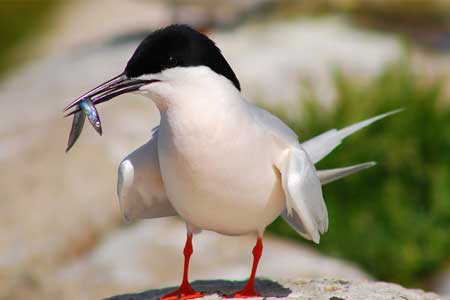 As we continue our exploration of Florida’s avian biodiversity, the spotlight now turns to the Roseate Tern, a delicate and elegant bird of the coastlines.
As we continue our exploration of Florida’s avian biodiversity, the spotlight now turns to the Roseate Tern, a delicate and elegant bird of the coastlines.
The Roseate Tern, aptly named for the faint blush of pink on its underparts during the breeding season, is enchanting. Adult birds are predominantly white, with a black cap that extends from the beak to the nape during the breeding season.
| Feature | Description |
|---|---|
| Size | Medium-sized bird, approximately 13-17 inches in length. |
| Color | Predominantly white, with a black cap during the breeding season and a slight pinkish tinge on the underparts. |
| Bill | Long, thin and black, turning red at the base in breeding adults. |
| Legs | Reddish-orange, notably short, lending to their distinctive flight silhouette. |
| Eyes | Dark. |
Roseate Terns inhabit coastal and island areas, nesting on sandy or pebbly beaches. They feed primarily on small fish, which they catch by performing graceful aerial dives.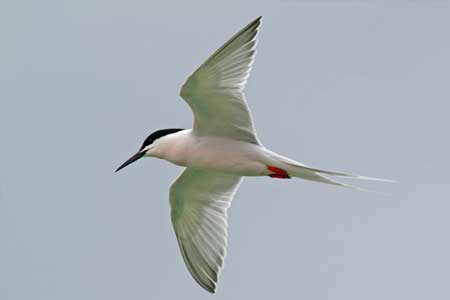
In Florida, Roseate Terns can be spotted along the state’s vast coastline, especially in the Keys. Globally, these birds are found in temperate and subtropical regions worldwide, with North America, Europe, and Australia breeding populations.
The presence of the Roseate Tern is of great significance to Florida’s coastal ecosystems. As top predators in the marine food chain, these birds play a good and critical role in maintaining balance. Their fish diet reflects the marine environment’s health, making them excellent indicators of ecosystem wellbeing.
Moreover, their nesting habits can provide valuable information about shoreline conditions. Changes in nesting patterns may signal alterations in beach habitats, prompting necessary conservation actions.
With its grace and beauty, the Roseate Tern adds to the charm of Florida’s coastal landscapes and plays an essential part in maintaining the health and balance of these crucial ecosystems. As we strive to understand and preserve the state’s rich avian biodiversity, species like the Roseate Tern offer us invaluable insights and fascinating discoveries.
The Beautiful Rose-Breasted Grosbeak
 In our ongoing journey through the myriad avian species that grace the state of Florida, we now introduce the Rose-Breasted Grosbeak, a songbird renowned for its striking appearance and melodious song.
In our ongoing journey through the myriad avian species that grace the state of Florida, we now introduce the Rose-Breasted Grosbeak, a songbird renowned for its striking appearance and melodious song.
The Rose-Breasted Grosbeak, with its contrasting colors and distinctive features, is a sight to behold. The males, particularly during the breeding season, are the showstoppers. They sport black and white plumage with a splash of rose red on their breast, from which they get their name. Females and young birds, with streaked brown and white plumage, are less conspicuous.
| Feature | Description |
|---|---|
| Size | Medium-sized bird, approximately 7-8.5 inches in length. |
| Color | Males have black and white plumage with a rose-red breast; females and young birds are brown and white. |
| Bill | Large, conical, and white or pale. |
| Legs | Dark. |
| Eyes | Dark. |
The Rose-Breasted Grosbeak favors deciduous woodlands and forest edges where it dines on a diverse diet of insects, seeds, and fruits. It’s a migratory bird, spending the breeding season in North America and wintering in Central and South America.
For bird watchers hoping to nicely catch a glimpse of these beautiful creatures, listening to their song is often the best way to locate them. They are known to beautifully produce one of the most melodic songs in the bird world, often described as a ‘robin in opera.’
The Rose-Breasted Grosbeak plays a vital role in enhancing Florida’s bird diversity. It contributes to the state’s vibrant ecosystems through its feeding habits. By consuming a variety of insects, these birds help control pest populations. Also, their seed-eating habits assist in dispersing many plant species, thus supporting biodiversity.
In conclusion, the Rose-Breasted Grosbeak is a fascinating bird that adds to the stunning biodiversity of Florida. Their unique features and melodious songs offer a delightful sight and sound for bird watchers and highlight Florida’s ecosystems’ incredible diversity and intricate balance.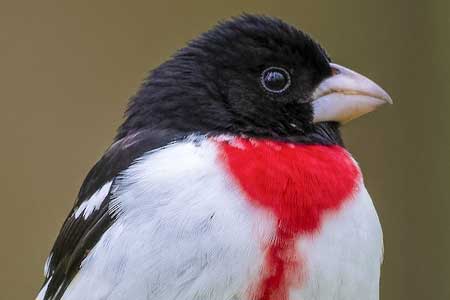
Conclusion
As we conclude our deep dive into the kaleidoscopic world of Florida’s pink birds, it becomes apparent that our feathered friends are not just splashes of color dotting our skies but vital cogs in the wheel of nature. The vibrancy of the Scarlet Ibis, the Roseate Tern’s elegance, the Rose-Breasted Grosbeak’s charm, and the delightful finches all add layers of complexity and beauty to Florida’s ecosystems.
The pastime of birdwatching is not merely a hobby; it’s a window into the intricate workings of nature. It reinforces the urgency of wildlife conservation, urging us to preserve these species and their habitats for future generations.
Florida’s bird diversity is a treasure trove waiting to be explored. We encourage our readers to immerse themselves in this fascinating world, to observe, appreciate, and help protect these magnificent creatures.
Appendix:
Here are a few easy and clever tips for all the aspiring bird-watchers out there:
Recommended Equipment: Good-quality binoculars, a field guide for bird identification, comfortable clothing, and a notebook for field notes.
Best Birdwatching Spots in Florida: Everglades National Park, Merritt Island National Wildlife Refuge, also Corkscrew Swamp Sanctuary.
Birdwatching Etiquette:
- Respect nature and wildlife.
- Maintain a safe distance from the birds.
- Avoid disturbing their habitats.
- Remember that your actions can impact the birds and other bird-watchers.
References
- Birds of Florida Field Guide. A book by Stan Tekiela. Amazon Link
- Sibley Field Guide to Birds of EN America. A book by David Allen Sibley. Amazon Link

Ivelina Dimitrova is a seasoned journalist with extensive experience spanning various facets of the media industry. Over the years, she has worked in numerous newspapers and magazines, contributing thoughtful articles that reflect her deep understanding of various topics. Ivelina’s journalism career also extends to radio and regional television stations, where her articulate and compelling narratives have reached a broader audience. Her commitment to truth, accuracy, and storytelling has earned her a respectable place in the industry, and she continues to dedicate her craft to enlightening and engaging her readers and listeners.

Interesting article! I want to add that the Roseate Tern is also known for its distinctive two-note call, which is another excellent way to identify it.
The Ding Darling National Wildlife Refuge on Sanibel Island is another excellent place for birdwatching in Florida.
Great read! Remember, patience is critical in birdwatching. Sometimes, you must wait hours before you spot the bird you’re looking for.
Nice article, but remember the importance of responsible tourism. Stick to marked trails to avoid disturbing bird habitats.